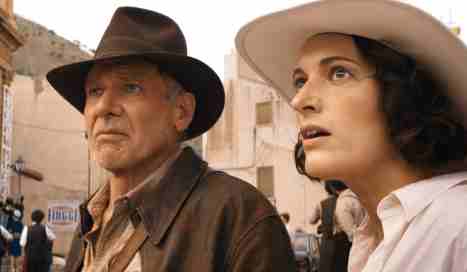By Andrew Jenck
Attempting to revive Indiana Jones in the same spirit as the original trilogy is challenging. A film series with violence that could alienate children and on location shooting a rarity in the age of CGI spectacle, a new entry was likely never going to reach the same heights as its predecessors. Steven Spielberg and George Lucas themselves fell short with Kingdom of the Crystal Skull, with its overblown set pieces and lack of grit. Indiana Jones and the Dial of Destiny, helmed by James Mangold of Logan and Ford v. Ferrari fame, attempts to remedy the last outing’s faults by having grounded set pieces, being more conscious of Harrison Ford’s age, and a cautious approach to the story. In doing so, the absence of the auteur duo is felt in lack of freneticism and creativity, giving Indy a passable but unremarkable bow, one that shows potential without courageously seizing it.
As with the last sequel following a polarizing entry, the Nazis return in the form of NASA scientists during the Space Race where Dr. Jones is roped into an adventure by his shady goddaughter, attempting to sell a dial crafted by Archimedes on the black market. The premise is sound, providing a good reason to have familiar foes, and new historical elements with a nonreligious artifact. Unfortunately, whenever these new ideas are approached, the script retreats to familiar territory; often feeling like a greatest hits compilation. Most of the set pieces intend to invoke the originals by having similar scenarios and settings. Being a reliable filmmaker, Mangold is stable in his set pieces though not to his full extent in his previous work. Perhaps restricted by Ford’s age, the action can feel a bit slow, chase sequences go a tad too long, others held back by dimly lit cinematography. Action is at its best when Jones thinks on the fly, finding clever ways to escape.
Harrison Ford fully commits and slips back into the fedora with ease, emoting a sense of irrelevancy and sorrow while maintaining his sass and ingenuity. Phoebe Waller-Bridge makes for a good foil, having little regard for history while pointing out his own faults. Dr. Jones is more pragmatic, often finding hidden solutions while she is a quicker thinker, making for a fun dynamic. Unfortunately, Ethann Isidore is given few opportunities to stand out and can feel like a redundancy of Short Run without much personality. Mads Mikkelsen is despicably fun as a post-war Nazi, though could’ve been given more material. The ethics of the U.S. Government using “ex-Nazis” is brushed off by the second half and highlights how the film stays in its comfort zone.
Although not overly nostalgic as other legacy revivals, The Dial of Destiny always retreats to familiar territory after skidding over new ideas. Understandably, it can’t reach the heights of some of the most influential action films and may be good to play it safe after Crystal Skull. An off kilter, cleverly set up climax reveals the filmmaker’s capacity that could’ve been fulfilled had either they or the studio had more confidence. It feels like this is the true apex of Jones’ archeology career, strengthening his character arc, creating a solid allegory of living in the past. Had this experimentation been present throughout, then this could’ve been a full return to form while commenting on nostalgic filmmaking instead of just being caught in the past.
Indiana Jones and the Dial of Destiny is an easy watch: competent, more cohesive than most other blockbusters, glimpses of ambition, and a breezy adventure. Its setbacks prevent one from full engagement, as the lack of Lucas’ creativity and Spielberg’s direction is never compensated. It has a stable base of familiarity that tries to build up new ideas and characters but falls short of fully developing them. Nevertheless, it makes for a fun matinee-type watch and serves a decent epilogue to the revered adventure series. Just as an artifact, it has worn with time but still has value.


